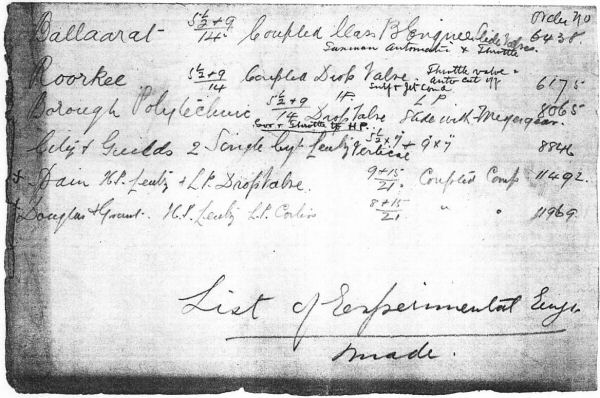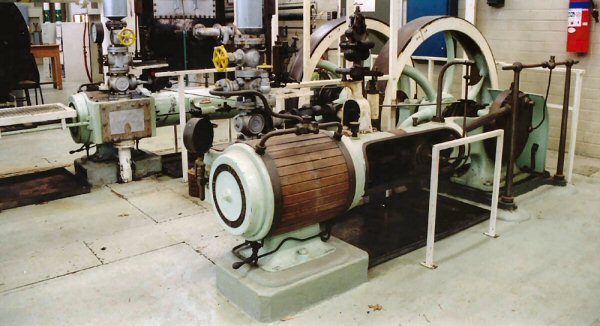Paxman Experimental/Teaching Steam Engines
During the early years of the twentieth century Paxman provided a number of experimental or teaching steam engines to educational and training institutions both in the UK and overseas. I think it highly probable these were supplied on very favourable terms with a keen eye to the potential commercial benefits. No doubt some individuals and organisations considering the purchase of a steam engine would seek advice and recommendations from senior members of staff at such institutions. Perhaps more importantly, many of the young men attending these institutions would, later in their careers, occupy senior engineering appointments and play major roles in deciding what steam engines should be purchased by their employers' organisations. It was much to Paxman's advantage that college staff, and young engineers under their tutelage, should become familiar with Paxman as a progressive and innovative builder of high quality engines. Another probable benefit was access to the results of experiments and studies carried out in these institutions under the direction of well-qualified academic staff; information which Paxman could feed back into the ongoing development of its engines.
Rohan Lamb, curator of the stationary steam engine museum at the National Steam Centre, Melbourne, Australia, wrote to the Essex Record Office with a query in 2001. Whilst dealing with the query the archivist at the ERO stumbled across a piece of paper, tucked in the front of a book, which listed six experimental engines made by Paxman. An image of that handwritten note is shown below.

The surviving copy order book entries for each of the engines listed on the note are shown below. To each entry has been added the relevant comment on the handwritten note, expanded (in italics) where appropriate for the sake of clarity. Other additional notes are also in italics.
Order No: 6175
Date Entered in Order Book: 6 Sep 1900
Description: 5½" + 9" x 14" Coupled Compound Condensing Girder Engine
Official Order Date: 8/00647 (presumably India Office order no.) 30/8/1900
Registered No: (blank)
Who For: India Office (The British Government department responsible for India matters in the days of British rule in India.)
Where Sent: Rorkee College (should be Roorkee, north of Delhi, India.)
Date Sent: (blank)
Handwritten Note: 5½" + 9" / 14" Coupled Drop Valve (Engine). Throttle valve (governor) & auto cut off. Surf(ace) & jet cond(enser).
Order No: 6438
Date Entered in Order Book: 15 Oct 1901
Description: 8 HP Coupled Compound Girder Engine 5½" + 9" x 14"
Official Order Date: 4/9/01
Registered No: (blank)
Who For: Ballarat School of Mines
Where Sent: (blank. Ballarat, Victoria, Australia.)
Date Sent: (blank - but installed in 1902.)
Handwritten Note: 5½" + 9" / 14" Coupled Class B Engine. Slide Valves. Paxman Automatic (expansion gear) + throttle (valve governor).
Addditional Note: To the best of my knowledge this is the only Paxman experimental/teaching engine which has survived. As at 2009 it is in the Sovereign Hill Gold Mining Museum's historical collection store facility (near Ballarat), in a dismantled state, until a suitable place can be found to display it in the museum. > > more

The engine at the University of Ballarat before transfer to Sovereign Hill.
Order No: 8065
Date Entered in Order Book: 23 Jul 1906
Description: Coupled Compound Experimental (Engine) 5½" + 9" x 14"
Official Order Date: (blank)
Registered No: 14007
Who For: Borough Polytechnic (college)
Where Sent: Borough Road, London
Date Sent: 10 Jun 1907
Handwritten Note: 5½" + 9" / 14". HP (High Pressure cylinder) Drop Valve. LP (Low Pressure cylinder) Slide (Valve) with Meyer gear. Gov(ernor) & throttle (valve) to HP (High Pressure cylinder).
Order No: 8846
Date Entered in Order Book: 14 Jul 1908
Description: Two vertical Single Crank H S (i.e. High Speed) Engines 5½" x 7"
Official Order Date: 29/6/08
Registered No: (blank)
Who For: City & Guilds of London Institute
Where Sent: Finsbury (Technical College, London)
Date Sent: 20 Sep 1909
Handwritten Note: 2 Single Cyl Lentz vertical. 5½" x 7" & 9" x 7".
Additional Notes:
1. The order book description of the engines, as shown above, is basically correct except that the second engine was of 9" bore x 7" stroke as per the handwritten note. A surviving Paxman microfilm record of the order contains the following comments: "2 x vertical single crank double acting high speed open type … to be arranged so that they can be connected together by a coupling shaft when required to run as a compound engine." The HP cylinder to be 5½" x 7" and the LP to be 9" x 7", to run at 400rpm. Drawings to be approved by Prof Coker. Paxman also to supply 'test bars' 3" square by 6 foot long "for experiments in conductivity such as described in proceedings of Institute of Civil Engineers Vol 131 - 1891-8 on the law of condensation of steam, etc." The test bars were made of cylinder metal and also the liner metal. The instructions were that the cylinder material test bars were to be cast at the same time as the cylinders and covers.
2. By 1932 the engines were at University College, Gower Street, London.
Order No: 11492
Date Entered in Order Book: 4 Mar 1912
Description: Experimental Engine 9.15.21 (i.e. a compound - 9" + 15" x 21")
Official Order Date: (blank)
Registered No: 17521
Who For: Navas & Co (Paxman's agent in Spain)
Where Sent: Bilbao (Spain)
Date Sent: 20 Feb 1913
Handwritten Note: Spain. HP Lentz (valve gear) & LP Drop Valve. 9" & 15" / 21" Coupled Compound.
Order No: 11969
Date Entered in Order Book: 19 Nov 1912
Description: Horizontal Coupled Compound Experimental Engine 8.15.21
Official Order Date: (blank)
Registered No: 17999
Who For: Douglas & Grant
(Why was an experimental engine supplied to Douglas & Grant, a Scottish firm of steam engine builders? Were they acting on behalf of an educational or training institution, perhaps because they had no suitable engine of their own to offer?)
Where Sent: Kirkcaldy (Scotland)
Date Sent: 29 Aug 1913
Handwritten Note: HP Lentz, LP Corliss (valve gear). 8" + 15" / 21".
Two more experimental engines not listed on the handwritten note were:
Order No: 6674
Date Entered in Order Book: 28 May 1902
Description: Special Experimental Compound Engine 5¾" + 9½" x 14"
Official Order Date: 27 May 1902
Registered No: 11473
Who For: Royal Indian Engineering College (Founded in 1870, the college was set up to provide technical training for those going out to work in India and other places in the then British Empire. It closed in 1907.)
Where Sent: Cooper's Hill (Egham, Surrey).
Date Sent: May 1903
Order No: 12524
Date Entered in Order Book: 19 December 1913
Description: Experimental Coupled Compound Girder Engine 5½" + 9" x 14"
Official Order Date:
Registered No: 18554
Who For: India Office.
Where Sent: Lucknow, India.
Date Sent: 22 May 1914
The engines listed above, with the varied types of valve gear employed, are clear evidence of Paxman's interest in innovation and experimentation in the early years of the 20th century. It is fair to conclude that the Company was keen not only to promote its engines to young engineers but also to encourage investigation into the performance of simple and compound engines and the respective merits of different types of valve gear such as slide valves with Meyer gear, drop valves, Lentz and Corliss valve gear.
If anyone knows of any of the above engines having survived, other than the Ballarat engine, would they please contact me with details.
© Richard Carr 2009
Page updated: 15 JUN 2009
